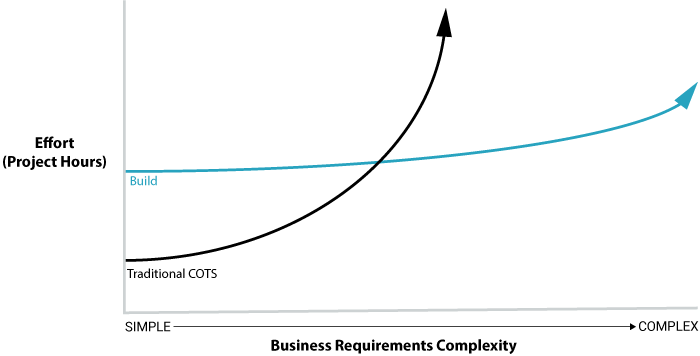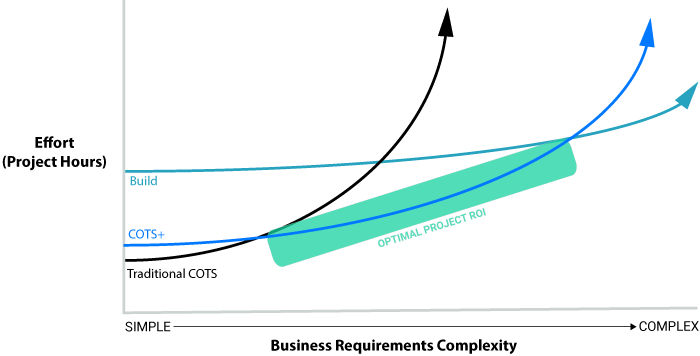For most government agencies, the conventional approach towards enterprise software procurement has focused on two potential implementation approaches:
While it’s tempting to oversimplify these two options as, “paying more to get almost exactly what you want,” vs, “paying less to get most of what you need,” the reality is each approach has its own distinct and well documented pros and cons.*

In addition to considering the various organizational and project impacts of these two approaches, it is also imperative to gauge the projected ROI of buy (COTS) vs build (custom) over the entire lifecycle of each approach. Doing so elevates your procurement analysis beyond mere organizational and project requirements to establish the intrinsic value proposition for each of these solutions.
Is a picture worth a thousand words? The above chart certainly may be. Within this simple graphic, one can immediately grasp and compare the value propositions derived from our buy and build options. More importantly, these two divergent lines enable us to fully understand the projected ROI for each approach across the entirety of their respective product lifecycles. Let’s take a closer look.
For many years, this A/B choice of ‘building custom vs buying COTS‘ has been the classic conundrum that government agencies have wrestled with in their deliberations over which approach will yield the best value for project stakeholders and citizens alike. Each approach had it’s own distinct advantages; each had its own limiting trade offs contingent upon project, budget and staff constraints. This is now changing however with the ascent of the COTS+ solution.
Maintaining an industry unmatched 100% project success rate over 40+ years as a preferred provider of government software solutions, Computronix has been on the front lines through every evolutionary phase in the delivery and implementation of enterprise software. From in-house custom application development to commercial off-the-shelf software, we’ve built and deployed both custom and COTS solutions to meet the exacting requirements of our clients, in the process delivering government workflows solutions that yield true generational utility and return on investment. And, as the technology and our expertise has grown, we have identified and developed a new hybrid approach to software development that elegantly overcomes the tradeoffs inherent in conventional buy vs build analyses. It is an approach we call COTS+
Quite simply, a COTS+ Solution is the best of both worlds, providing the off-the-shelf feature maturity of a traditional COTS product with the underlying configuration flexibility of custom built software. COTS+ solutions, like those built on our proprietary POSSE Platform, leverage a powerful workflow configuration and business rules engine that empowers agencies to develop their own custom workflows and citizen services. This robust configuration toolset is seamlessly integrated with a range of mature and feature rich COTS+ solutions providing immediate out-of-the-box functionality for a range of traditional government agency applications (including permitting, alcoholic beverage control, and more) WITHOUT the core configuration limitations of traditional COTS solutions. Utilizing our elegant low code POSSE development platform, government agencies can utilize business friendly drag-and-drop interfaces leveraging pre-built user interface (UI) functionality and designs, business processes, logic, and data models to build, test and deploy full-stack, cross-platform apps—in a fraction of the time required for complex code developments.

The value proposition for a COTS+ solution becomes readily apparent, once we overlay the expected lifecycle curve for our new COTS+ approach over our previous comparison model as per the chart above.
Given the complexity and scope of its underlying configuration platform, a COTS+ solution begins its project lifecycle with slightly more effort and expense to implement than a traditional COTS solution. Compared to a custom build however, the COTS+ solution requires substantially less effort to implement, providing more cost efficiencies than a custom built solution by a significant margin. As project requirements grow in complexity, a COTS+ solution tracks closely to the value curve for a traditional COTS solution until the project reaches a point of medium complexity. It is here that a COTS+ solution truly shines in comparison to both the traditional buy and build approaches. For all but the most complex software implementations, a COTS+ solution works elegantly to maintain project/cost efficiency throughout its lifecycle, avoiding the precipitous spike of traditional COTS solutions lacking underlying configuration flexibility, while also tracking significantly more efficient than cost prohibitive custom built solutions.
In this particular race to requirements, it is only in the latter stages of a significantly complex project implementation that the build your own approach offers the superior value proposition, but here it is worth emphasizing that only a small percentage of government agency implementations ever match the substantially complex requirements for this type of late stage lifecycle solution. The vast majority of government enterprise software implementations reside in the realm of medium to reasonably complex project requirements where the COTS+ solution value proposition truly excels.
This powerful hybrid approach places COTS+ solutions in a procurement ‘sweet spot’ for government agencies seeking the product certainty and speed-to-market of an existing off-the-shelf solution in tandem with the extended lifecycle value of a low code development and workflow automation platform. In short, a COTS+ solution empowers a legitimate ‘best of both worlds’ procurement approach for government agencies keen to overcome the limitations associated with conventional buy or build models for enterprise software implementation.
*To help guide your evaluation of these and other considerations, please visit the link provided for additional information.
Looking for more information? Subscribe to our CX blog below to stay in the loop on the latest news, best practices and emerging trends in government technology.